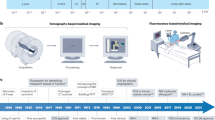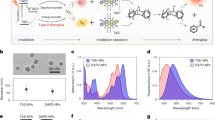Abstract
Deep tissue imaging in the second near-infrared (NIR-II) window holds great promise for physiological studies and biomedical applications1,2,3,4,5,6. However, inhomogeneous signal attenuation in biological matter7,8 hampers the application of multiple-wavelength NIR-II probes to multiplexed imaging. Here, we present lanthanide-doped NIR-II nanoparticles with engineered luminescence lifetimes for in vivo quantitative imaging using time-domain multiplexing. To achieve this, we have devised a systematic approach based on controlled energy relay that creates a tunable lifetime range spanning three orders of magnitude with a single emission band. We consistently resolve selected lifetimes from the NIR-II nanoparticle probes at depths of up to 8 mm in biological tissues, where the signal-to-noise ratio derived from intensity measurements drops below 1.5. We demonstrate that robust lifetime coding is independent of tissue penetration depth, and we apply in vivo multiplexing to identify tumour subtypes in living mice. Our results correlate well with standard ex vivo immunohistochemistry assays, suggesting that luminescence lifetime imaging could be used as a minimally invasive approach for disease diagnosis.
This is a preview of subscription content, access via your institution
Access options
Access Nature and 54 other Nature Portfolio journals
Get Nature+, our best-value online-access subscription
24,99 € / 30 days
cancel any time
Subscribe to this journal
Receive 12 print issues and online access
251,40 € per year
only 20,95 € per issue
Prices may be subject to local taxes which are calculated during checkout




Similar content being viewed by others
References
Smith, A. M., Mancini, M. C. & Nie, S. Bioimaging: second window for in vivo imaging. Nat. Nanotech. 4, 710–711 (2009).
Hong, G. et al. Through-skull fluorescence imaging of the brain in a new near-infrared window. Nat. Photon. 8, 723–730 (2014).
Ghosh, D. et al. Deep, noninvasive imaging and surgical guidance of submillimeter tumors using targeted M13-stabilized single-walled carbon nanotubes. Proc. Natl Acad. Sci. USA 111, 13948–13953 (2014).
Bruns, O. T. et al. Next-generation in vivo optical imaging with short-wave infrared quantum dots. Nat. Biomed. Eng. 1, 0056 (2017).
Wong, M. H. et al. Nitroaromatic detection and infrared communication from wild-type plants using plant nanobionics. Nat. Mater. 16, 264–272 (2017).
Sun, Y. et al. Novel bright-emission small-molecule NIR-II fluorophores for in vivo tumor imaging and image-guided surgery. Chem. Sci. 8, 3489–3493 (2017).
Jacques, S. L. Optical properties of biological tissues: a review. Phys. Med. Biol. 58, R37–61 (2013).
Bashkatov, A. N., Genina, E. A., Kochubey, V. I. & Tuchin, V. V. Optical properties of human skin, subcutaneous and mucous tissues in the wavelength range from 400 to 2000 nm. J. Phys. D 38, 2543–2555 (2005).
James, M. L. & Gambhir, S. S. A molecular imaging primer: modalities, imaging agents, and applications. Physiol. Rev. 92, 897–965 (2012).
Ntziachristos, V. Going deeper than microscopy: the optical imaging frontier in biology. Nat. Methods 7, 603–614 (2010).
Yun, S. H. & Kwok, S. J. J. Light in diagnosis, therapy and surgery. Nat. Biomed. Eng. 1, 0008 (2017).
Antaris, A. L. et al. A small-molecule dye for NIR-II imaging. Nat. Mater. 15, 235–242 (2016).
Dang, X. et al. Layer-by-layer assembled fluorescent probes in the second near-infrared window for systemic delivery and detection of ovarian cancer. Proc. Natl Acad. Sci. USA 113, 5179–5184 (2016).
Naczynski, D. J. et al. Rare-earth-doped biological composites as in vivo shortwave infrared reporters. Nat. Commun. 4, 2199 (2013).
Trivedi, E. R. et al. Highly emitting near-infrared lanthanide ‘encapsulated sandwich’ metallacrown complexes with excitation shifted toward lower energy. J. Am. Chem. Soc. 136, 1526–1534 (2014).
Chen, G. et al. Tracking of transplanted human mesenchymal stem cells in living mice using near-infrared Ag2S quantum dots. Adv. Funct. Mater. 24, 2481–2488 (2014).
Shao, W. et al. Tunable narrow band emissions from dye-sensitized core/shell/shell nanocrystals in the second near-infrared biological window. J. Am. Chem. Soc. 138, 16192–16195 (2016).
Hammond, M. E. et al. American Society of Clinical Oncology/College of American Pathologists guideline recommendations for immunohistochemical testing of estrogen and progesterone receptors in breast cancer (unabridged version). Arch. Pathol. Lab. Med. 134, e48–72 (2010).
Wolff, A. C. et al. Recommendations for human epidermal growth factor receptor 2 testing in breast cancer: American Society of Clinical Oncology/College of American Pathologists clinical practice guideline update. J. Clin. Oncol. 31, 3997–4013 (2013).
Lu, Y. et al. On-the-fly decoding luminescence lifetimes in the microsecond region for lanthanide-encoded suspension arrays. Nat. Commun. 5, 3741 (2014).
Niehorster, T. et al. Multi-target spectrally resolved fluorescence lifetime imaging microscopy. Nat. Methods 13, 257–262 (2016).
Yezhelyev, M. V. et al. In situ molecular profiling of breast cancer biomarkers with multicolor quantum dots. Adv. Mater. 19, 3146–3151 (2007).
Zhou, L. et al. Single-band upconversion nanoprobes for multiplexed simultaneous in situ molecular mapping of cancer biomarkers. Nat. Commun. 6, 6938 (2015).
Varghese, F. et al. IHC profiler: an open source plugin for the quantitative evaluation and automated scoring of immunohistochemistry images of human tissue samples. PLoS ONE 9, e96801 (2014).
Ramos-Vara, J. A. & Miller, M. A. When tissue antigens and antibodies get along: revisiting the technical aspects of immunohistochemistry—the red, brown, and blue technique. Vet. Pathol. 51, 42–87 (2014).
Walker, R. A. Quantification of immunohistochemistry—issues concerning methods, utility and semiquantitative assessment I. Histopathology 49, 406–410 (2006).
Robertson, E. G. & Baxter, G. Tumour seeding following percutaneous needle biopsy: the real story! Clin. Radiol. 66, 1007–1014 (2011).
Georgakoudi, I. et al. In vivo flow cytometry: a new method for enumerating circulating cancer cells. Cancer Res. 64, 5044–5047 (2004).
Ming, K. et al. Integrated quantum dot barcode smartphone optical device for wireless multiplexed diagnosis of infected patients. ACS Nano 9, 3060–3074 (2015).
Gorpas, D., Ma, D., Bec, J., Yankelevich, D. R. & Marcu, L. Real-time visualization of tissue surface biochemical features derived from fluorescence lifetime measurements. IEEE Trans. Med. Imaging 35, 1802–1811 (2016).
Gnach, A., Lipinski, T., Bednarkiewicz, A., Rybka, J. & Capobianco, J. A. Upconverting nanoparticles: assessing the toxicity. Chem. Soc. Rev. 44, 1561–1584 (2015).
Acknowledgements
This work was supported by the National Key R&D Program of China (2017YFA0207303), the National Natural Science Fund for Distinguished Young Scholars (21725502), the Key Basic Research Program of Science and Technology Commission of Shanghai Municipality (17JC1400100), the China Postdoctoral Science Foundation (KLH1615151), the Australian Research Council Discovery Early Career Researcher Award (DE170100821) and the Centre of Excellence for Nanoscale BioPhotonics (CE140100003).
Author information
Authors and Affiliations
Contributions
F.Z., Y.F. and Y.L. designed the project. Y.F. and R.W. synthesized the nanoparticles. Y.L., Y.F. and X.Z. built the optical system. P.W. and L.Z. conducted the animal experiments. Y.F. was primarily responsible for data collection. Y.F., Y.L. and F.Z. analysed the results, and prepared the manuscript, figures and Supplementary Information. All authors contributed to the discussion and editing of the manuscript.
Corresponding authors
Ethics declarations
Competing interests
The authors declare no competing interests.
Additional information
Publisher’s note: Springer Nature remains neutral with regard to jurisdictional claims in published maps and institutional affiliations.
Supplementary information
Supplementary Information
Supplementary Discussion, Supplementary Methods, Supplementary Tables 1–9, Supplementary Figures 1–22, Supplementary References
Rights and permissions
About this article
Cite this article
Fan, Y., Wang, P., Lu, Y. et al. Lifetime-engineered NIR-II nanoparticles unlock multiplexed in vivo imaging. Nature Nanotech 13, 941–946 (2018). https://doi.org/10.1038/s41565-018-0221-0
Received:
Accepted:
Published:
Issue Date:
DOI: https://doi.org/10.1038/s41565-018-0221-0



